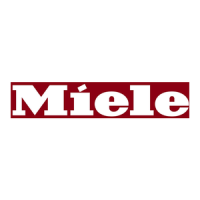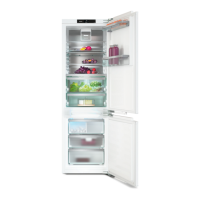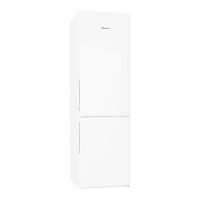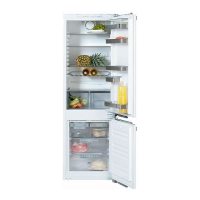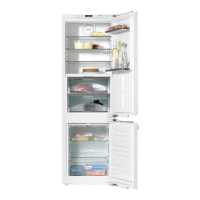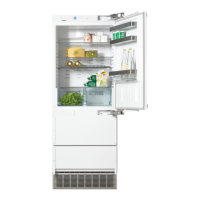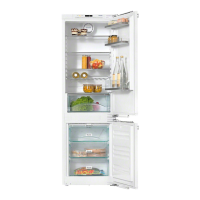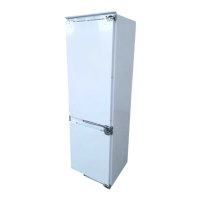Do you have a question about the Miele KFN 7734 F and is the answer not in the manual?
Defines the intended use of the refrigeration appliance in home and similar environments, excluding outdoor use.
Covers coolant circuit safety, refrigerant properties, noise, and damage prevention during transport/installation.
Details requirements for safe electrical connection, earthing, autonomous power systems, and hazards of extension leads.
Emphasizes following installation instructions, needing two people, door hinging, and housing unit requirements.
Covers operating within climate range, air vents, fat/oil contact, explosives, carbonated drinks, and frozen food handling.
Advises using original Miele accessories and guarantees for spare parts availability.
Warns against oils/grease on seals, steam cleaners, sharp objects, heaters, or defrosting sprays.
Advises upright transport in original packaging and safe handling due to weight.
Instructions for safe disposal, including door lock destruction and coolant handling.
Explains packaging materials are eco-friendly and should be recycled to reduce waste.
Guides on proper disposal, not using household waste and using designated collection points.
Details requirements for location: dry, well-ventilated, away from heat sources and direct sunlight.
Explains conditions for side-by-side installation, regarding humidity and model compatibility.
Specifies operating ambient temperature ranges (SN, N, ST, T) for the appliance.
Highlights importance of adequate ventilation to prevent overheating, energy use, and compressor damage.
Discusses gaps between appliance door and furniture for proper operation.
Provides guidelines on maximum door weight to prevent hinge damage and ensure functionality.
Shows required dimensions for installation in tall units or side views, with niche depth notes.
Illustrates ventilation cross-sections and mains cable connections for correct functioning.
Explains fitting pins to limit door opening angle to approximately 90 degrees.
Details requirements for safe electrical connection, including socket access, RCD, and cable replacement.
Provides tips on saving energy related to installation site, temperature settings, and appliance usage.
Identifies key internal and external components of the refrigeration appliance with numbered labels.
Explains control panel layout, temperature displays, sensor controls, and Miele@home status.
Introduces settings mode and lists functions like Party, Holiday, System Lock, and switching off.
Details functions like Sabbath mode, door alarm time, Miele@home setup, volume, brightness, unit change, demo mode, reset, cleaning mode.
Provides instructions on selecting functions within Settings mode and how to exit it.
Explains moving door shelves, egg trays, bottle holders, and adjustable shelves.
Details placing a baking tray and moving/replacing charcoal filters for odour control.
Lists supplied accessories (egg tray, bottle holder) and optional ones (cloths, filters).
Explains organisation box use and SoftClose hinges for quiet door closing.
Covers initial steps: removing packaging, cleaning, and connecting before first use.
Instructions on how to turn on the appliance and the initial cooling process.
Details how to switch off the entire appliance using the Settings mode.
Explains turning off only the refrigerator section, useful for holidays.
Advises on switching off for extended absences, including cleaning and airing.
Explains why correct temperature is vital for food shelf life and preventing spoilage.
Specifies recommended temperatures: 4°C for refrigerator, -18°C for freezer.
Describes temperature display operation and how to set temperatures in refrigerator/freezer sections.
Lists available temperature ranges for refrigerator (2-9°C) and freezer (-15 to -26°C) sections.
Explains SuperCool for rapid chilling, its operation, and usage tips.
Details SuperFreeze for rapid freezing, its conditions, and when it's not needed.
Describes DynaCool for even air circulation and when to use it for optimal cooling.
Introduces settings needing further explanation, like door alarm suppression.
Explains Party mode for rapid chilling/freezing and its interaction with other functions.
Describes Holiday mode for energy saving with minimal refrigerator cooling.
Covers activating/deactivating child lock to prevent accidental changes or switching off.
Explains Sabbath mode for religious observance, its function effects, and health risks.
Refers to Star-K certification for kosher observance.
Allows adjustment of the delay time for the door alarm to sound after door opening.
Introduces WiFi connectivity for remote appliance control via the Miele app.
Guides on connecting appliance to WiFi using Miele app or WPS.
Explains how to turn the WiFi connection on or off.
Details resetting Miele@home settings before selling or transferring the appliance.
Explains how to adjust or switch off appliance alarm and buzzer volumes.
Allows adjustment of display brightness to suit ambient lighting conditions.
Explains how to disable demo mode for dealer presentations, not domestic use.
Guides on resetting all appliance settings to factory defaults.
Shows appliance data like model and serial number, useful for service calls.
Explains activating the indicator for charcoal filter replacement.
Describes Cleaning mode for easier fridge zone cleaning, which switches off cooling.
Explains freezer temperature alarm system and its triggers (high temp, power cut, fault).
Details door alarm to prevent energy loss and food warming due to open door.
Describes temperature variations and zones created by natural air circulation.
Identifies warmest part and suggests storing butter and cheese there.
Identifies coldest areas for delicate and perishable foods.
Lists foods sensitive to cold temperatures below 5°C that should not be refrigerated.
Advises on purchasing food: freshness, dates, and minimizing time out of refrigeration.
Tips on proper food storage in packaging to prevent odours, drying, and cross-contamination.
Notes protein-rich foods deteriorate faster and provides examples.
Explains DailyFresh drawer for fruit/veg and humidity control.
Describes adjusting drawer lid for low humidity, suitable for excessively humid conditions.
Explains setting high humidity to retain moisture in stored food.
Advice on food placement, cleaning, humidity settings, and packaging for freshness.
Details quick freezing for preserving food quality and preventing moisture loss.
Advises on not exceeding the appliance's maximum freezing capacity per 24 hours.
Checks for buying frozen food and tips for transport and storage.
Guides on using SuperFreeze before freezing large quantities and selecting fresh food.
Advice on portioning, packaging, expelling air, and labelling food for freezing.
Warns about overloading and preventing contact between unfrozen and frozen food.
Explains removing drawers to fit large items like turkeys and optimizing freezing.
Provides a table with recommended storage times for various food groups.
Suggests SuperCool or Party mode for rapid drink cooling, warns about bottle bursting.
Instructions for filling and using the ice cube tray, and tips for removing cubes.
Explains automatic defrosting and keeping condensate channel clean.
Details the "NoFrost" system for automatic freezer defrosting and ice-free operation.
Lists recommended agents and warns against specific chemicals or abrasives.
Instructions on switching off cooling, interior lighting, and removing food/accessories.
Advises regular interior cleaning, condensate channel maintenance, and airing.
Lists components for hand cleaning and dishwasher-safe items (max 55°C).
Instructions for removing and cleaning door shelves, drawers, and compartment covers.
Guides on replacing filters every 6 months and confirming replacement via display.
Advises cleaning door seal with water, avoiding oils/grease.
Explains cleaning gaps maintains energy efficiency.
Steps after cleaning: reassembling accessories and restarting cooling.
Addresses appliance not switching on, plug issues, or tripped main fuse.
Explains continuous compressor run is normal for energy saving, not a fault.
Lists causes: blocked ventilation, frequent door opening, or improper installation.
Covers high ambient temp, incorrect settings, large loads, active Super functions.
Addresses ice build-up, improper door closure, and damaged door seals.
Explains causes for wet floor (blocked drain) and food freezing together (wet packaging).
Explains how to re-enable audible alarms if they were switched off in settings.
Explains demo mode symbol and how to switch it off.
Indicates cleaning mode is on and how to deactivate it.
Addresses blank display, likely due to Sabbath mode or appliance being off.
Explains lock function symbol and appliance unavailability.
Indicates filter needs replacement and how to confirm change.
Explains door alarm symbol/sound and acknowledgement.
Describes freezer temperature alarm, its causes, and initial actions.
Explains power interruption warning and resultant freezer temperature rise.
Details handling appliance faults indicated by code F, including contacting service.
Addresses interior lighting problems, checking appliance status or Sabbath mode.
Explains common noises like humming, gurgling, clicking, and cracking and their origins.
Addresses causes of rattling/vibration: uneven placement or touching items.
How to contact Miele service for faults, booking online, and required information.
Accessing EPREL database for energy labelling and finding model identifier.
Details warranty period and activation process, especially for the UK.
States compliance with EU Directive 2014/53/EU and provides links for the full text.
Declares compliance with UK Radio Equipment Regulations 2017 and provides links for the full text.
| Cord length | 2.2 m |
|---|---|
| Fridge interior light | Yes |
| Current | 10 A |
| Connected load | - W |
| AC input voltage | 220 - 240 V |
| AC input frequency | 50 Hz |
| Energy efficiency scale | A to G |
| Annual energy consumption | 283.6 kWh |
| Icemaker | - |
| Noise level | 35 dB |
| Climate class | SN-ST |
| Total net capacity | 253 L |
| Lamp type | LED |
| Fridge net capacity | 183 L |
| Number of vegetable drawers | 1 |
| Fridge number of shelves/baskets | 5 |
| Star rating | 4* |
| Freezer position | Bottom-placed |
| Freezing capacity | - kg/24h |
| Freezer net capacity | 70 L |
| Freezer number of shelves/baskets | 3 |
| Storage time during power failure | - h |
| Door hinge | Right |
| Control type | Touch |
| Door assembly | Door slider |
| Shelves material | Glass |
| Custom panel-ready | No |
| Appliance placement | Built-in |
| Depth | 546 mm |
|---|---|
| Width | 559 mm |
| Height | 1770 mm |
| Weight | 74500 g |
| Installation compartment depth | 550 mm |
| Installation compartment width | 570 mm |
| Installation compartment height | 1788 mm |
